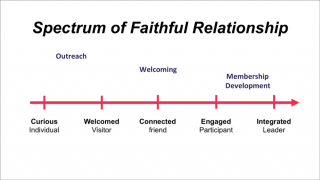What if Membership Was a Spectrum?
Part of Membership

As Unitarian Universalists, we have a traditionally operated under a model of church that doesn’t acknowledge the changing social norms about religion. Historically, we’ve only kept track of one aspect of involvement in church life, “membership”, which typically means signing a congregation’s membership book and making an annual pledge. But in reality, people interact with faith communities in dozens of different ways beyond the traditional notion of membership, often deepening and stepping back over the course of their lives. If we truly believe that everyone in our faith movement matters, whether they are official members or not, it is clear we need to re-conceive what it means to be connected to Unitarian Universalism.
We created a spectrum to help congregations see that there are distinct levels of belonging to our faith communities. Together, as leaders in the UU Association of Membership Professionals and as UUA staff working on outreach, we offered a workshop at 2015 General Assembly about how to engage the whole spectrum.
Curious Individual
These are the people who know us and are in sync with our values, but not involved in our programs or ministries. Some examples would include those who participate in community activities related to a UU group, follow UUs on social media, share UU content, read UU books, see and/or support UU social justice actions.
Welcomed Visitor
Those who are involved with UU programs or ministries at a basic or fluid level, and may or may not identify as UU, are at this stage. They may attend events hosted by UU congregations, go to Sunday services occasionally or participate in UU community-oriented ministries and programs (e.g. day care, lecture series). Sometimes they have a friend or family member who serves as a tie to the congregation.
Succeeding in the first two stages (outreach)
- Pay attention to how you show up virtually (website, social media, Yelp/Google/search functions, news media), so you look as beautiful from the outside as you do from the inside.
- Create multiple entry points that don’t revolve around Sunday morning (get creative! Get passionate!) AND pay attention to visitor experience at all of these entry points.
- One transition between welcomed visitor and connected friend is the traditional “pathway to membership,” but support is needed for all transitions.
Connected Friend
After attending services several times, those who attend a one time or low commitment activity outside of services have become a connected individual. This gives them better opportunities to meet people and start building relationships. Having several easy opportunities, like a Circle Dinner, one time small group, helping set up at an event or serving coffee give new folks a way to meet others without making a big commitment.
Engaged Individual
When a person gets involved in a regular activity, such as an affinity group, small group ministry, religious education teacher or serving on a committee, they have engaged with the community. All of these programs require ownership in one way or another, an expectations of regular participation and, in many cases, opportunities to share spiritual journeys with each other.
Integrated Leader
At the final stage in the spectrum, individuals emerge as leaders. We have found that as someone steps into the role of a leader they are more than simply engaged with a community, but they are also integrated. And by being integrated they are changing the community. They put their own personal twist on the programs they lead and that is a deeper level in involvement then just showing up, even on a regular basis. You become an integrated leader when you are willing to put your efforts into making the community better. Some examples would be a committee chair, small group leader or religious professional.
Succeeding along the spectrum (welcoming and membership development)
- Make sure facilitators and leaders of groups know how to welcome newcomers at each stage as people enter the spectrum at different points.
- Have training in place for leaders to ensure they have healthy boundaries and motives consistent with the mission of your congregation.
- Have a tracking system in place to know where people fall on the spectrum. This will be an invaluable resource for recruiting for programs and volunteer opportunities, discovering emerging leaders, as well as those who need assistance in connecting.
- We need to understand that there will be people who move both directions on the spectrum, and even leave our path. We want to support them in their journey and leave room for them to comfortably return should their path bring them back.
Looking at these stages calls us to pay attention to how we help people move from one stage to another. Again, most of us will move up and down the spectrum over time, but transitions between stages will always be important for religious leaders to support (the transition of “bridging” from youth to young adulthood is a great example). We hope this model will inspire UUs to think differently about their faith, from outreach to curious individuals all the way to spiritual enrichment for our integrated leaders. It can even include non-congregational groups, conferences or ministries. Embrace the full spectrum!